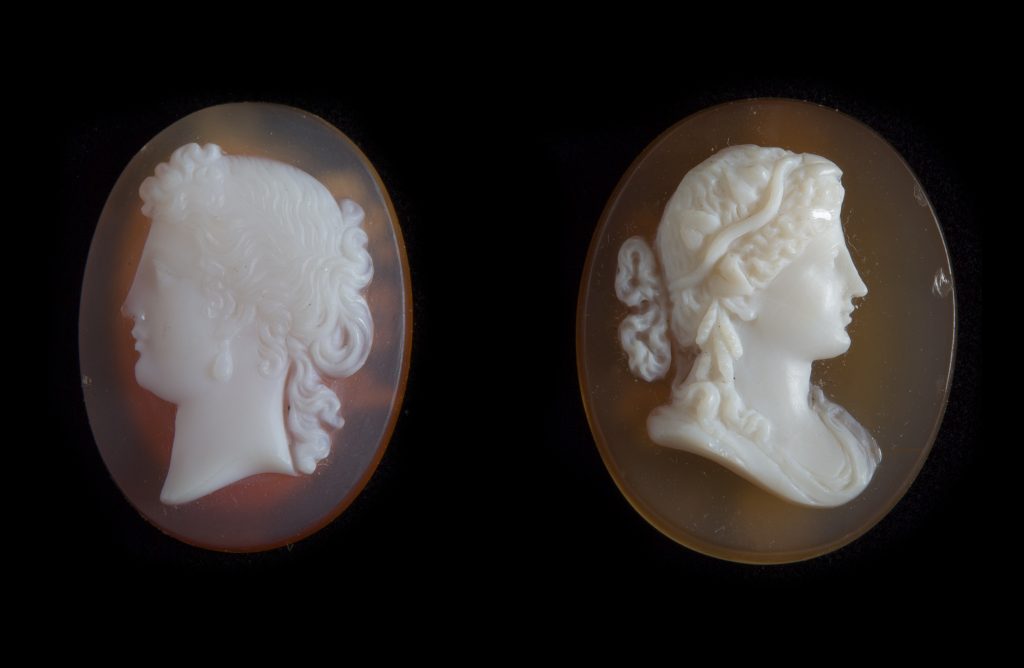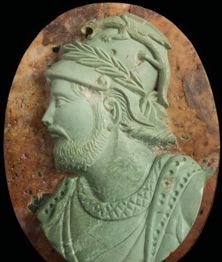ABOUT THE EXHIBIT
Cameo carving began as far back as the late Paleolithic era and continued until the Hellenistic Greeks took it up and brought it to an entirely new level. Alexander the Great was actually responsible for commissioning the first cameo portrait. Back then, the pieces of gemstone were carved by manipulating various types of drills against the stones, not actually using the points of the drills, but using them to rub powders into the stone to wear away at each layer. Over the centuries, cameos have enjoyed much recognition in the fashionable circles of many different civilizations. In Ancient Rome they were used as seals, sigils, jewelry, talismans, and emblems of an individual’s faith or personal identity. Often they were placed on helmets, breastplates, sword handles, and armor fastenings. Some were even given as sacrificial offerings to temples. Julius Caesar was known for his love of cameos and collected at least six cabinets of engraved gems and cameos to dedicate to the temple of Venus. During the Middle Ages, cameos fell out of style and lost favor. Yet with the Renaissance and the renewed interest in ancient Greco-Roman arts, cameos were reborn with better tools and techniques. In this time, cameos were regarded as a high art form and considered a sign of high intellect.
IMAGE CREDIT
Left: Unknown, Raphael, 18th-19th century. Cornelian agate. Collection of Phoenix Art Museum, Gift of Pierre J. and Velma J. Touraine Image credit: © Phoenix Art Museum. All rights reserved.
In the 18th and 19th centuries, when these particular cameos were created, cameos had what could only be called their “Romantic period.” During this time, the quality of carving excelled, and soon they became popular subjects for necklaces, bracelets, earrings, and diadems, and often were simply collected for private gem cabinets. Many schools for gem carving existed in Rome and Florence making cameos the popular choice for souvenirs when travelers toured Italy. Even Napoleon was delighted with cameos and actually collected many pieces for himself. His love for art lead him to found a school in Paris to teach cameo carving. He even covered his coronation crown, the Couronne de Sacre, with them and wore it on his wedding day. Other well-known cameo collectors of this time included Elizabeth I of England, Madame de Pompadour of France, Catharine the Great of Russia, Empress Josephine of France, and Empress Maria Fyodorovna of Russia.
While the art has had its ups and downs throughout history, it still continues today with communities of skilled cameo artists in Germany, Italy, Japan, Panama, Russia, Turkey, and the United States.
Though little is known about who created these particular cameos, it is clear that after they were gathered together, the collection was sold to Phoenix Art Museum Trustee and famed jewelry designer, Pierre Touraine, in 1944. After a brief public exhibition in Glendale, California in 1954, the cameos remained in the Touraine’s private collection until they were donated to Phoenix Art Museum in 1983. This exhibition will mark the first time these cameos will be shown in Phoenix and only the second recorded instance of them ever being shown to the public. While the individual artists remain unidentified, each cameo in this collection offers a unique window to the past for all who take the opportunity to see them.
IMAGE CREDIT
Unknown, Siegfried, c. 1876-1900. Green variscite on brown matrix. Collection of Phoenix Art Museum, Gift of Pierre J. and Velma J. Touraine Image credit: © Phoenix Art Museum. All rights reserved.
Featuring more than 20,000 objects, the collection spans the globe, bringing the world to our city, and our city to the world.
Discover a world of programs, workshops, and more, and experience your museum in a whole new way.
EXHIBITIONS
On view for a limited time, exhibitions present art from across the centuries and the globe, from iconic fashion to Old Master paintings, contemporary photography to historical objects of Asia.
MOREARTISTS IN THE COLLECTION
Discover the biographies, histories, and works of featured artists in the Phoenix Art Museum Collection.
MORECOLLECTIONS
Featuring more than 20,000 objects in nine collecting areas, the collection spans many cultures and periods, bringing the world to our city, and our city to the world.
MORE





